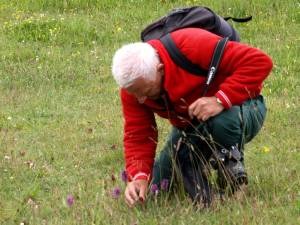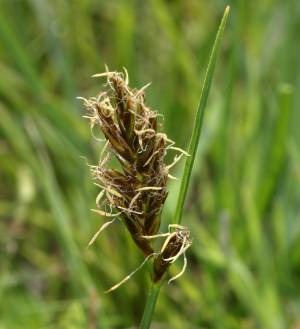Dr Phil Smith’s Wildlife Notes
June 2008
June is a great month for our sand-dune flowers, especially the orchids which bloom in spectacular variety and abundance. The carefully managed damp grasslands at Altcar Rifle Range are home to an estimated 50-60,000 wild orchids, a truly inspirational sight for visitors on organised guided walks. On 13th June, Alan Gendle, the orchid expert from Cumbria, travelled down to help sort out the confusing diversity of different marsh-orchids at Altcar. In total, we listed at least 14 different orchid species, hybrids and named varieties, including one last seen on the coast in 1935! However, we couldn’t name several others, so an invitation is going to the country’s leading specialist, Prof. Richard Bateman of The Royal Botanic Gardens at Kew, to visit Altcar next year.

The Rifle Ranges also provided two new colonies of a less dramatic-looking but equally important plant. This is Flat Sedge (Blysmus compressus), one of the most rapidly declining species in Britain. As it is listed for special attention in the Botanical Society’s “Rare Plants Project”, I have begun a detailed survey of its distribution and abundance on the Sefton Coast. Already, I have found much more than was previously known about, with 12 sites and a total area of nearly 2500 square metres occupied by the plant.

Bird-watchers usually find June a quiet month but a few rarities invariably turn up. This time they included a Wilson’s Phalarope (an American wader), which was an exciting find on 3rd-4th June at Seaforth, where a Roseate Tern appeared later in the month. Marshside had its near-resident Glossy Ibis, while a Spoonbill attracted visitors to Martin Mere. During the gale on 22nd June, hardy sea-watchers at Formby Point logged two Storm Petrels. An early hint of autumn was provided by Green and Wood Sandpipers, perhaps failed breeders, already returning to Martin Mere from 10th and 21st June respectively.
The Dragonfly Atlas survey is ongoing, those attending my training event at Mere Sands Wood on 14th June being rewarded by sightings of eight species. A new record for Cabin Hill on 29th was a Black-tailed Skimmer (Orthetrum cancellatum), while Broad-bodied Chasers (Libellula depressa) were seen quite widely in our area. Both these dragonflies are rapidly extending their ranges northwards in response to climate change and they may turn up, together with several other species, at garden ponds. For details on how to identify dragonflies and participate in the survey, visit the Lancashire Atlas web-site at www.dragonflies.org.uk. Although large parts of the Birkdale Green Beach lagoons dried up during the month, it looks as though enough water survived to ensure reasonable breeding success for the Natterjack Toad. I counted a record number of 266 spawn strings this spring, suggesting that the total population is well over 500 adults. I need to make further inquiries but the Green Beach is now quite possibly the single most important British breeding site for this endangered amphibian
